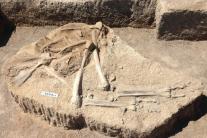Giant camel coming to University's Geology Museum
Wed, 12/02/2015 - 11:33am(Extracted from an article by Holly Duchmann in The Advocate, August 2015)
One giant, long-dead camel is finding a permanent home in the downtown Lafayette Science Museum. Found in modern-day south-central Oregon, the 7 million-year-old giant camel, also known as the Megatylopus, stood a towering 12 to 14 feet tall when it was alive.
University of Louisiana at Lafayette research professor James Martin found the specimen, which while partial is still the most complete skeleton of the species found to date. "Clearly, this is a monumental find," said Kevin Krantz, museum director. "This is something that nobody else in the world has as much as we do of this particular skeleton. We currently hold more of this animal than any other collection in the world."
The specimen will debut with the third installment of the "Prehistoric Giants" exhibit presented by UL Lafayette and the Lafayette Science Museum.
"We can't put values on this," Krantz said. "I'm going to say it's invaluable, because I personally abhor the thought of fossils being marketed and sold. These are resources. "It's something that we hold very close to the cuff, because we don't want the science behind these animals exploited. In terms of rarity, clearly it's very valuable as a fossil find," Krantz said.
Krantz said the museum's goal is to eventually mold and cast the skeleton so it can be reproduced, though that depends on how much of the animal's remains can be found in the future.
Martin, who said he hopes to return to the Oregon site in the future to look for the rest of the camel, is a research professor in the School of Geosciences and is the curator of paleontology.

